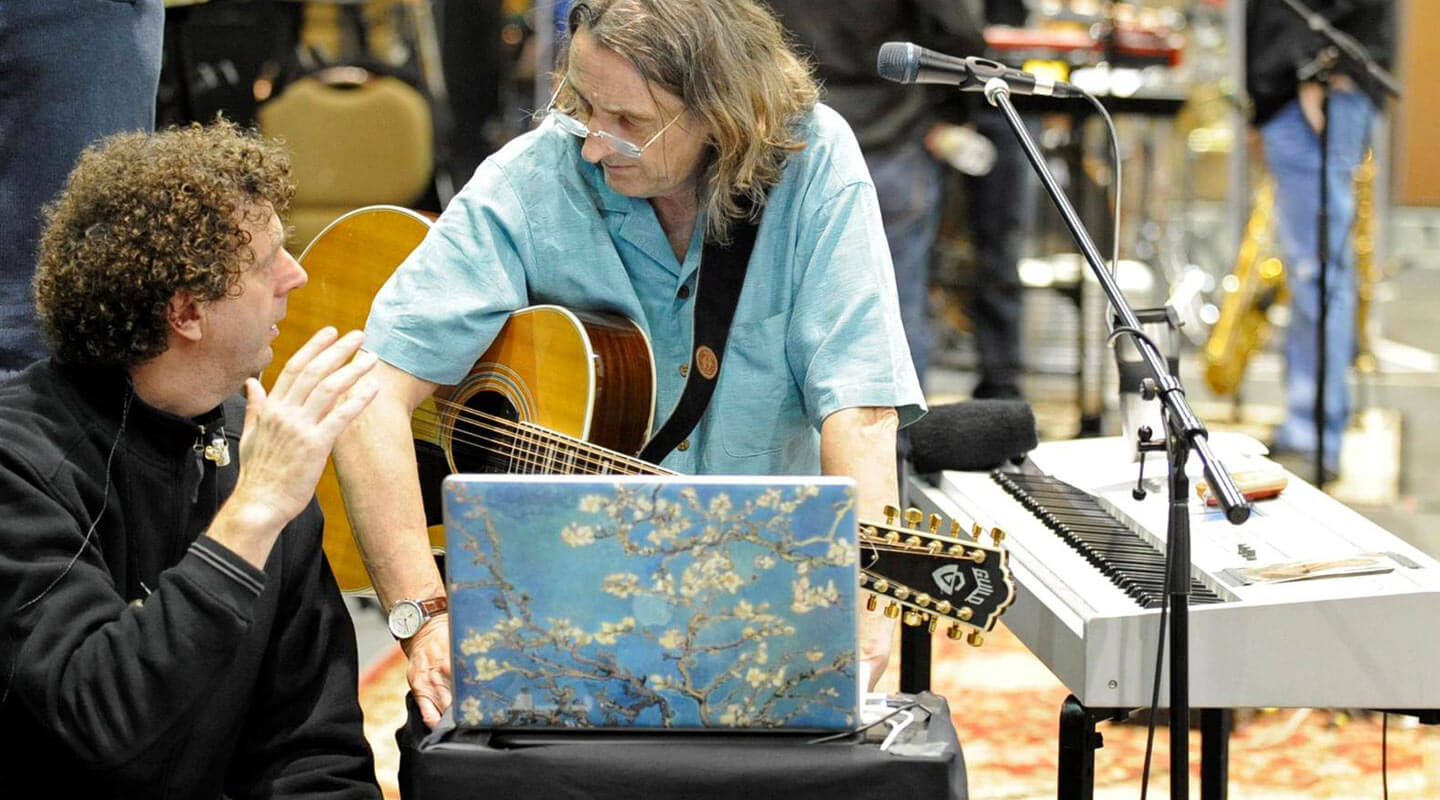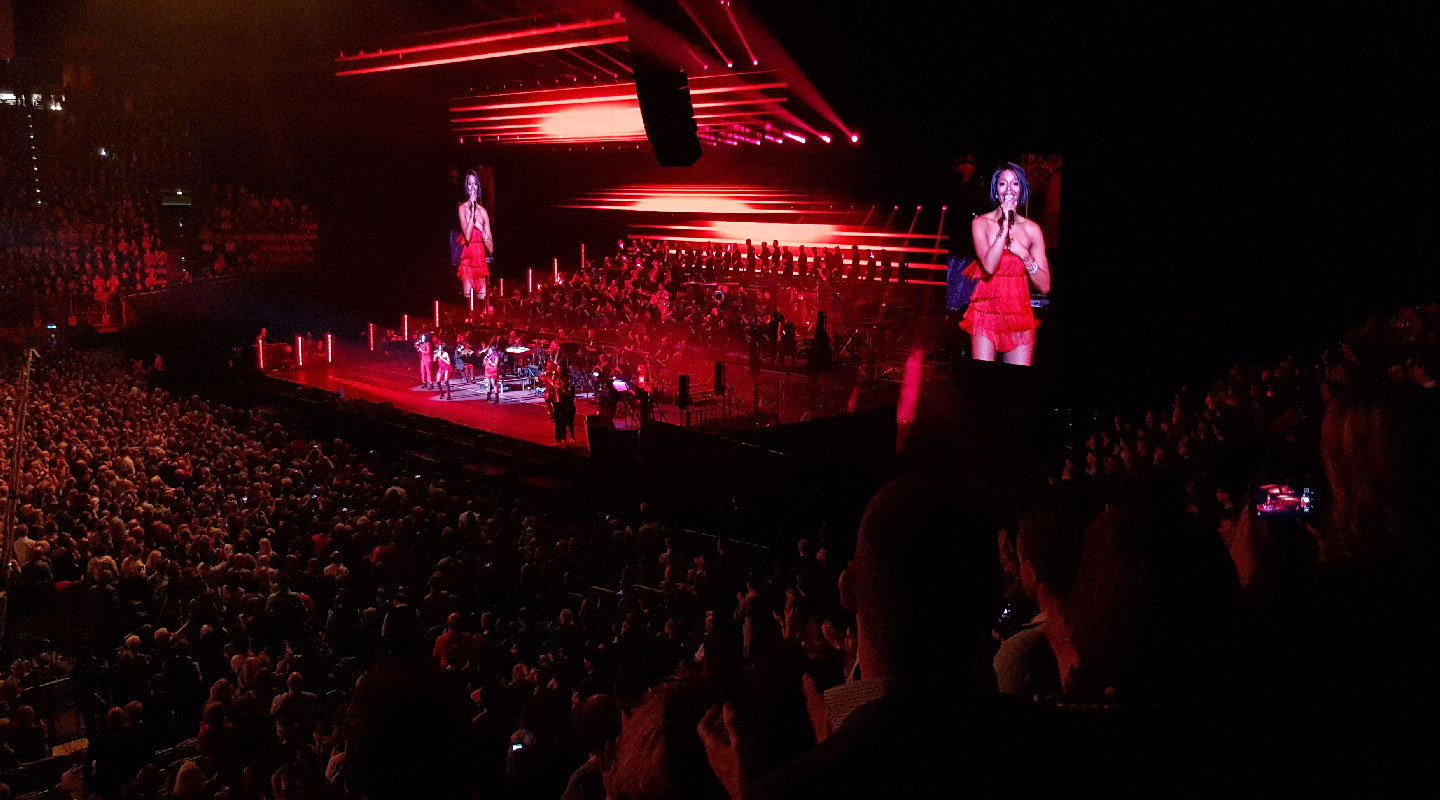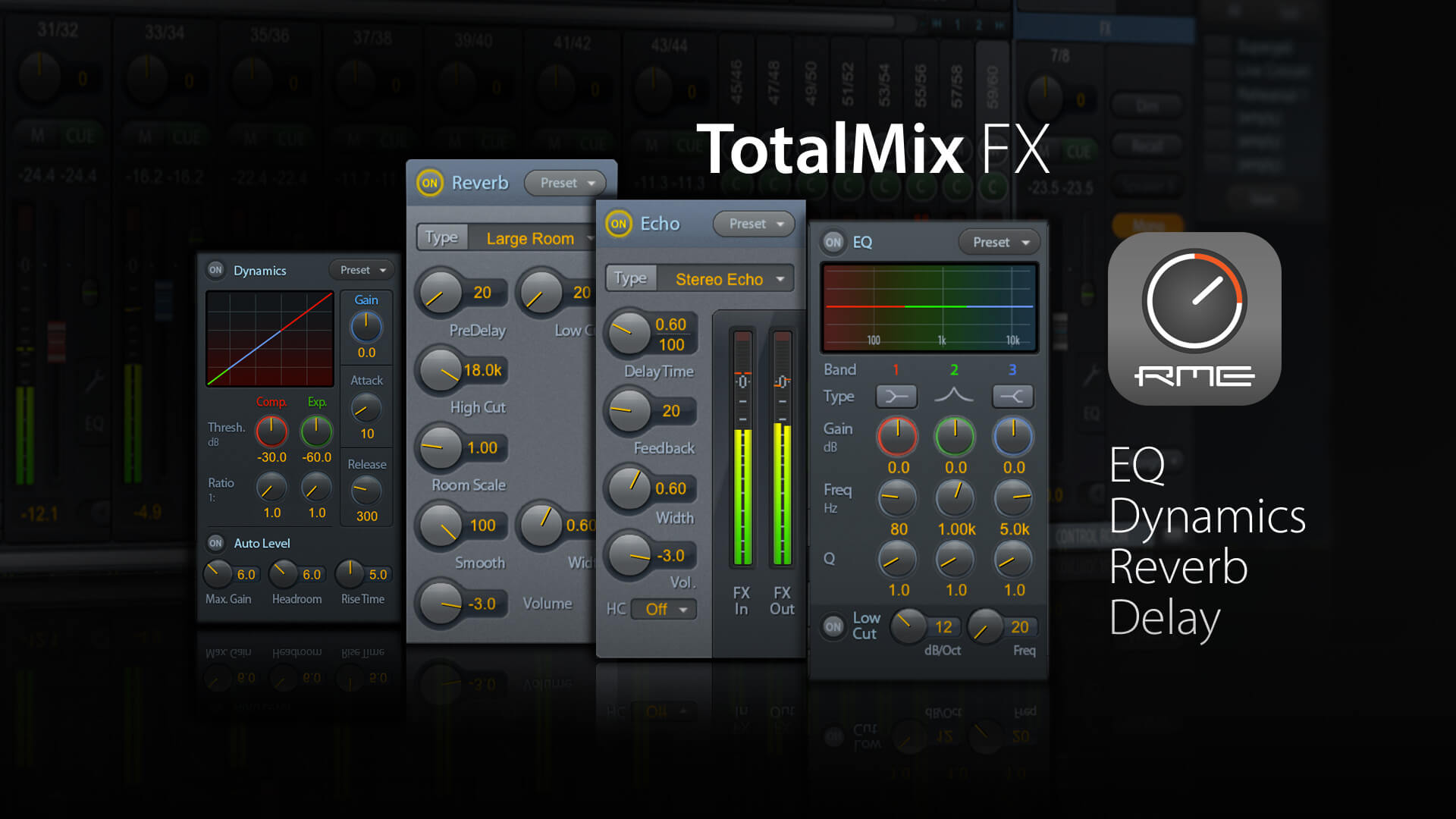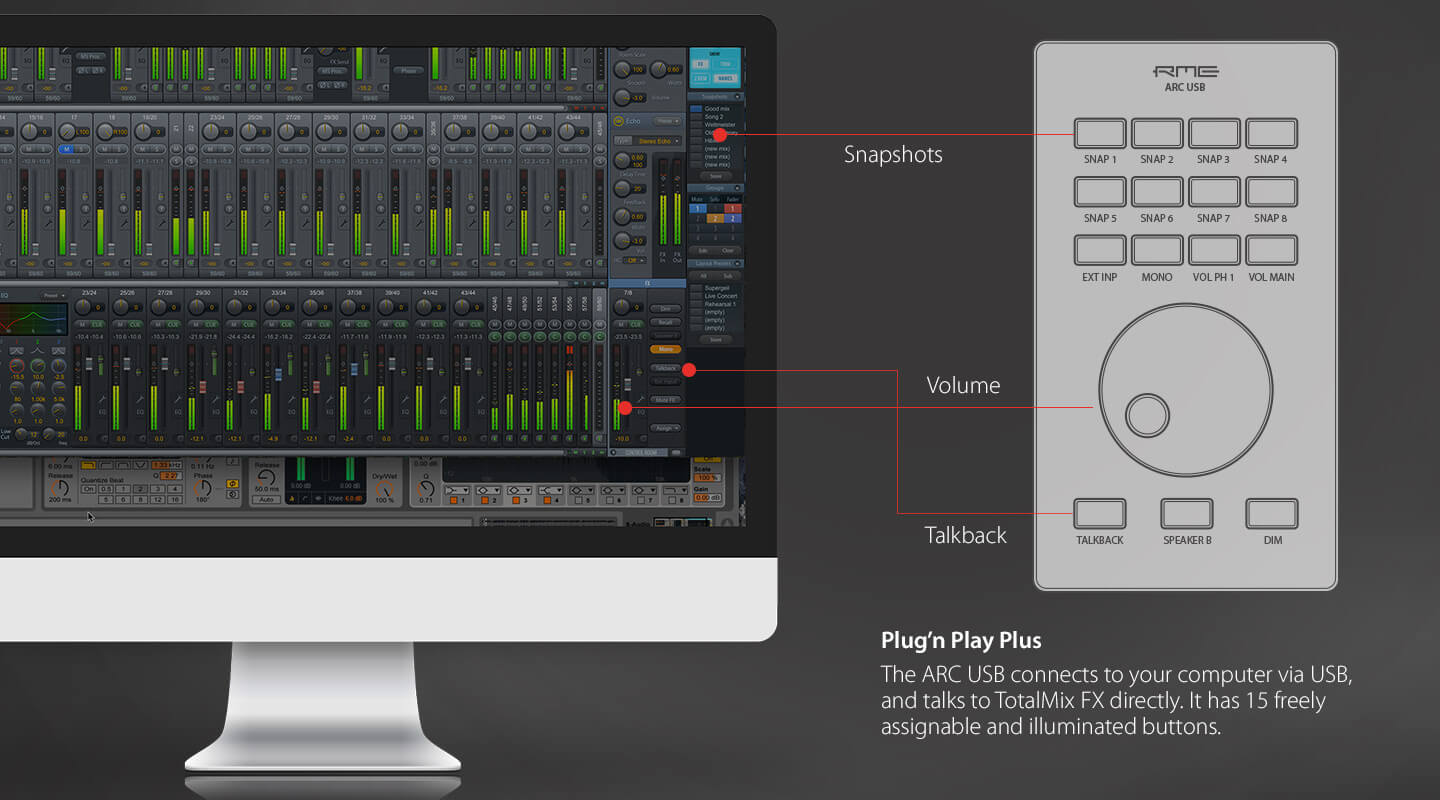Fireface UFX II
60-Kanal, 24-Bit/192kHz high-end USB Audio Interface
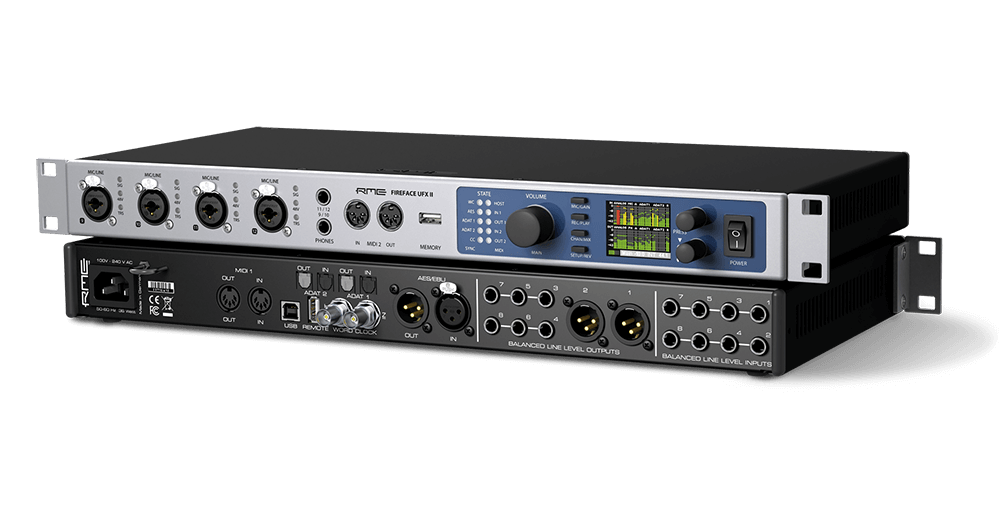

Anschlüsse und Features
Fireface UFX II - Das USB Flaggschiff-Interface
Seine außerordentliche Flexibilität und Kompatibilität, das eingebaute DURec (direktes Aufnehmen auf USB), die legendäre RME 'Low Latency'-Hardware und Treiber machen das Fireface UFX II zu einem Audiosystem, das gleichermaßen ambitionierte Heimanwender wie auch professionelle Tonstudios anspricht.
Mit 60 Audiokanälen (30 Eingänge und 30 Ausgänge), Unterstützung von Samplefrequenzen bis zu 192 kHz und der Flexibilität durch den USB-Anschluss stellt das Fireface UFX II die Ideallösung für einen breitgefächerten Einsatz im Bereich Recording, Mixing und Monitoring dar.
Die exzellente Flexibilität erlaubt es, das UFX II in eine schier unbegrenzte Anzahl von Arbeitsumgebungen nahtlos einzubinden. Analog, ADAT, AES, SPDIF und USB-2 sind Standard beim Fireface UFX II. Genauso beeindruckend ist die Kanal-Anzahl: 12 analoge, 16 ADAT und 2 AES Kanäle bieten jeweils 30 Ein- und 30 Ausgänge. Dank USB-2-Anschluss kann das UFX II auch mit der optimal erhältlichen RME ARC USB (Advanced USB Remote Control) betrieben werden.
Brandneue AD/DA-Wandler, optimierte analoge I/O-Schaltungen sowie ein verbesserter Rauschabstand und Klirrfaktor garantieren unverfälschten, kristallklaren und transparenten Klang. Ein neues PAD-loses Mikrofon-Schaltungsdesign mit einem maximalen Eingangspegel von +18 dBu und einem Gain-Bereich von 75 dB eignet sich für reibungslose Aufnahmen in jeder Situation mit jeder Quelle.
Neue ‘Hi-Power’-Kopfhörerausgänge mit niedriger Impedanz (2 Ohm) und einem maximalen Ausgangspegel von +19 dBu bieten ausreichend Leistung und Lautstärke für jede Art von Kopfhörer, ob mit hoher oder niedriger Impedanz.
Flexibles Routing & Mixing mit TotalMix FX
Seit 2001 bietet TotalMix FX unbegrenztes Routing und Mixing für RME Audio-Interfaces. Seine einzigartige Fähigkeit, so viele unabhängige Sub-Mixes zu erstellen wie Ausgangskanäle verfügbar sind, hat es zum flexibelsten und mächtigsten Mischer seiner Art gemacht.
Mit der entsprechenden unterstützten Hardware steht mit TotalMixFX ein komplettes Effektsystem zur Verfügung, was nicht nur für mehr Flexibilität in der Aufnahmekette sorgt, sondern auch latenz-belastete Software-Lösungen überflüssig macht.
TotalMix FX for iPad™ bietet volle Kontrolle über Hardware-Mischer und DSP-Effekte für Fireface UFX+, UFX II, UFX, UCX, 802, Babyface, Babyface Pro und MADIface Pro im Class-Compliant-Modus. Darüber hinaus erlaubt es das Erstellen, Speichern und Laden kompletter Mischungen direkt auf dem iPad™.
TotalMix FX beinhaltet ein komplettes Effekt-System: EQ, Reverb, Dynamik & Delay
DC-gekoppelte Ausgänge - CV/Gate Voltage Control
Die meisten Audio-Interfaces sind traditionell mit sogenannten "AC-gekoppelten Ausgängen" ausgestattet, bei denen Kondensatoren verwendet werden, um extrem tiefe Frequenzen herauszufiltern.
Während diese Frequenzen im Audiobereich generell als unerwünscht gelten, da sie den Headroom aufzehren und möglicherweise andere Geräte beschädigen können, ist die DC-Kopplung in der Welt der modularen Synthesizer wünschenswert, wo statische oder langsame Signale zur Steuerung verschiedener Parameter wie Tonhöhenwerte oder LFOs verwendet werden.
Alle Line-Pegel-Ausgänge des Fireface UFX II sind vollständig DC-gekoppelt und erlauben das Senden von Steuerspannungen (CV) oder Gate-Informationen an modulare Synthesizer (wie z.B. die populären Eurorack- und Moog/MOTM/Synthesizer Formate) und andere Studio-Hardware.
TotalMix FX für iPad™ App
TotalMix FX for iPad™ bietet volle Kontrolle über Hardware-Mischer und DSP-Effekte für Fireface UFX+, UFX II, UFX, UCX, 802, Babyface, Babyface Pro und MADIface Pro im Class-Compliant-Modus. Darüber hinaus erlaubt es das Erstellen, Speichern und Laden kompletter Mischungen direkt auf dem iPad™.
Weitere herausragende Merkmale
TotalMix FX -Mixing / Routing mit überragenden Funktionen für Studio und Live Anwendungen
Seit 2001 erweitert TotalMix die Audio-Interfaces von RME um unbegrenztes Routing und Mixing. Seine einzigartige Fähigkeit, so viele unabhängige Submixe zu erstellen, wie Ausgangskanäle zur Verfügung stehen, machte es zum flexibelsten und leistungsfähigsten Mixer seiner Art.
DigiCheck - Die Geheimwaffe für hochauflösende Audiomessverfahren
RMEs einzigartige Software-Toolbox zum Testen, Messen und Analysieren digitaler Audio Signale. 2, 8 oder alle Kanalpegelmesser mit unzähligen Optionen. Spektralanalysator, Goniometer und Bitstatistik in professioneller Qualität.
SteadyClock FS - Referenzklasse für Digitale Taktung
Hervorragende Leistung in allen Clock-Modi und hochwertige Analogwandlung, um Ihren Mix so zu hören, wie er ist, mit geringstem Jitter und höchster Jitter-Immunität.
Room EQ in TotalMix FX
The latest Room EQ addition provides an optimized handling of the existing 3-band PEQ in TotalMix FX, including 9-band PEQ, Volume Calibration and Crossfeed function.
ARC USB Fernbedienung - Plug’n Play Plus
Die ARC USB wird per USB mit dem Computer verbunden und kommuniziert direkt mit TotalMix FX. Sie ist mit 15 frei zuweisbaren, beleuchteten Tastern, einem Encoder-Rad und einem Klinkenstecker zum Anschließen eines Fußschalters ausgestattet.
Die ARC USB ist eine USB 1.1 MIDI-Fernbedienung für das Fireface UFX II. Da sie als Gerät der UAC 1 Klasse arbeitet ist sie nativ kompatibel mit Windows und Mac OS X. Sobald sie im Betriebssystem angemeldet ist, wird die ARC USB automatisch von TotalMix FX erkannt, die Kommunikation zur Steuerung des UFX+ findet per einfacher MIDI-Befehle statt.
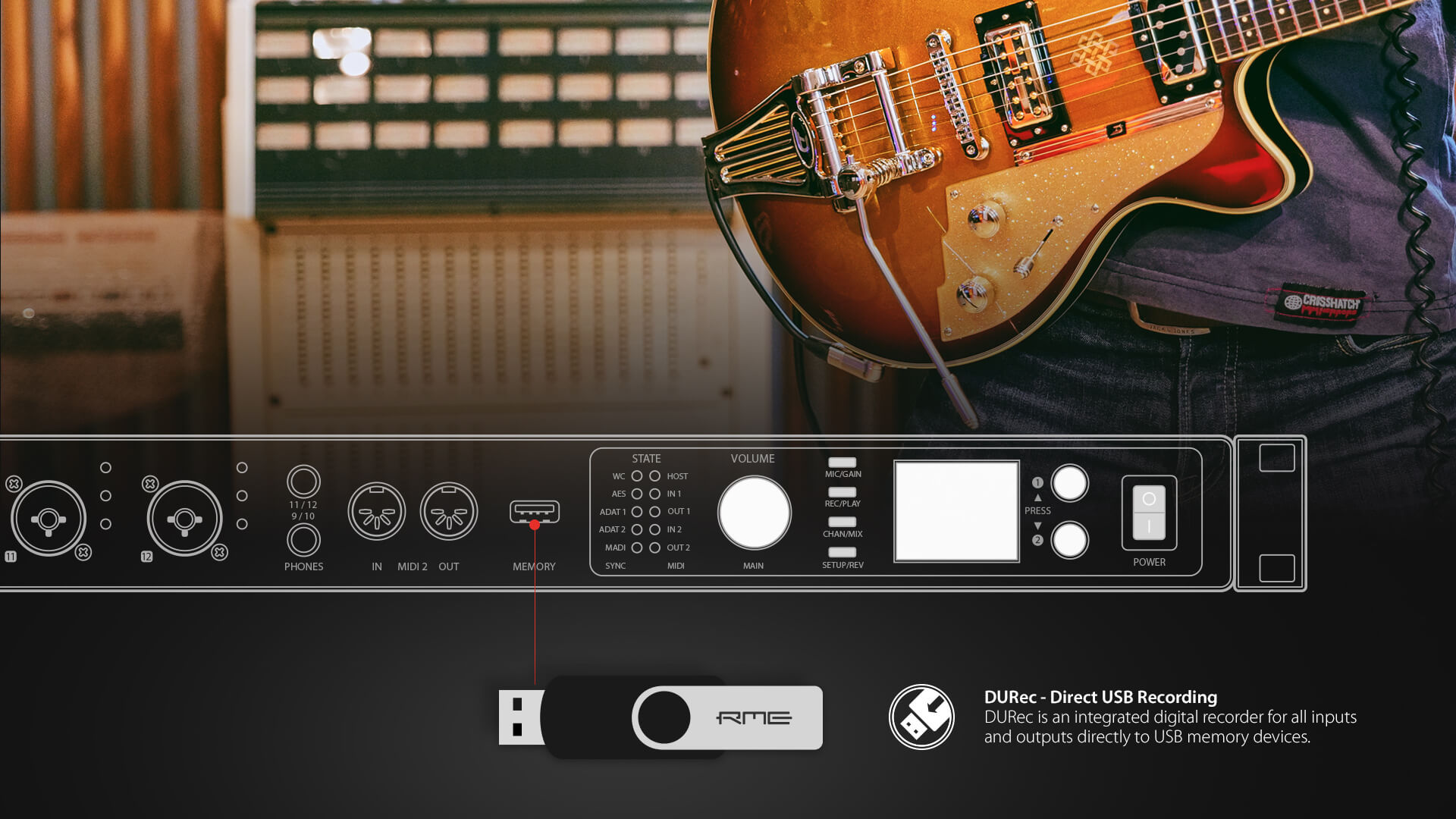
Alle 60 Ein- und Ausgangskanäle können für die Aufnahme und Wiedergabe individuell ausgewählt werden.
Direct USB Recording (DURec)
DURec ist ein integrierter digitaler Recorder für alle Ein- und Ausgänge. Über den vorderen USB-Anschluss können dort direkt USB-Speichergeräte angeschlossen und zur Aufnahme genutzt werden.
Das Fireface UFX + und Fireface UFX II kann auf USB-Sticks oder Festplatten mit einer Kapazität von bis zu 2 TB aufnehmen. Die Aufnahmefunktionalität wird vom internen DSP bereitgestellt und ist daher unabhängig von einem angeschlossenen Windows- oder Mac-Computer. Die Direct USB-Aufnahme konvertiert das Fireface UFX Serie sowohl in einen eigenständigen Field-Recorder als auch in einen leistungsstarken Multichannel-Live-Player für frühere Aufnahmen. Virtuelle Soundchecks, Live-Konzerte, Bandproben oder spontane Jam-Sessions können direkt aufgenommen und vom Medium abgespielt werden - sogar völlig eigenständig ohne Computer oder Software.
Tech-Specs
Fireface UFX II
Analoger Teil
AD, Line In 1-8, Rückseite
- Eingang: 6,3 mm Stereoklinke, servosymmetrisch
- Rauschabstand (SNR) @:LoGain: 116 dB (AES17), 118 dBA
- Rauschabstand (SNR) @:+4 dBu: 115 dB (AES17), 117 dBA
- Frequenzgang @ 44.1 kHz, -0,1 dB: 8,9 Hz – 20,4 kHz
- Frequenzgang @ 96 kHz, -0,5 dB: 4,3 Hz – 45,2 kHz
- Frequenzgang @ 192 kHz, -1 dB: 3 Hz – 89 kHz
- Filter: Short Delay Sharp, 5 / 5 / 6 Samples Latenz
- THD @ -1 dBFS: < -120 dB, < 0,0001 %
- THD+N @ -1 dBFS: < -110 dB, < 0,00032 %
- Übersprechdämpfung: > 110 dB
- Maximaler Eingangspegel: +19 dBu
- Eingang: 6,3 mm Stereoklinke, elektronisch symmetriert
- Eingangsimpedanz @ 1 kHz: 10 kOhm unsymmetrisch, 10,6 kOhm symmetrisch
- Eingangsempfindlichkeit schaltbar Lo Gain und +4 dBu
- Eingangspegel für 0 dBFS @ +19 dBu: +19 dBu
- Eingangspegel für 0 dBFS @ +4 dBu: +13 dBu
- Variabler Gain: 0 bis +12 dB
- Minimaler Eingangspegel für 0 dBFS: +1 dBu, -1,2 dBV
Mikrophon In 9-12, Frontseite
Wie AD, aber:
- Eingang: XLR, elektronisch symmetriert
- Eingangsimpedanz @ 1 kHz: 3,4 kOhm
- Rauschabstand (SNR) @ 0 dB Gain: 117 dB (AES17), 119,5 dBA
- THD+N @ -1 dBFS, Gain 20 dB: < -110 dB, < 0,00032 %
- Frequenzgang @ 44.1 kHz, -0,1 dB: 10,7 Hz – 20,3 kHz
- Frequenzgang @ 96 kHz, -0,5 dB: 5,1 Hz – 45,0 kHz
- Frequenzgang @ 192 kHz, -1 dB: 3,5 Hz – 88 kHz
- EIN @ 60 dB Gain, 150 Ohm, A-Weighted: -129.8 dBu
- Regelbereich Gain: 75 dB
- Maximaler Eingangspegel, Gain 0 dB: +18 dBu
- Maximaler Eingangspegel, Gain 75 dB: -57 dBu
- CLIP LED: 0 dBFS
- SIG LED: -60 dBFS
Instrument In 9-12, Frontseite
Wie AD, aber:
- Eingang: 6,3 mm Monoklinke, unsymmetrisch
- Eingangsimpedanz @ 1 kHz: 1 MOhm
- Rauschabstand (SNR): 116 dB (AES17), 118,5 dBA
- Frequenzgang @ 44.1 kHz, -0,5 dB: 2,4 Hz – 20,0 kHz
- Frequenzgang @ 96 kHz, -1 dB: 1,6 Hz – 28 kHz
- Frequenzgang @ 192 kHz, -3 dB: 0,8 Hz – 54 kHz
- THD+N @ -1 dBFS, Gain 20 dB: < -107 dB, < 0,00045 %
- Regelbereich Gain: 42 dB
- Maximaler Eingangspegel, Gain 8 dB: +21 dBu
- Maximaler Eingangspegel, Gain 50 dB: -21 dBu
DA, Line Out 3-8, Rückseite
- Ausgang: 6,3 mm Stereoklinke, servosymmetrisch
- Rauschabstand (SNR) @ HiGain: 116,5 dB (AES17), 118.5 dBA
- Rauschabstand (SNR) @ +4 dBu: 116 dB (AES17), 118 dBA
- Rauschabstand (SNR) @ -10 dBV: 107 dB (AES17), 109 dBA
- Frequenzgang @ 44.1 kHz, -0,1 dB: 0 Hz – 20,2 kHz
- Frequenzgang @ 96 kHz, -0,5 dB: 0 Hz – 44,6 kHz
- Frequenzgang @ 192 kHz, -1 dB: 0 Hz – 77,5 kHz
- Filter: Short Delay Sharp, 6 / 6 / 6 Samples Latenz
- THD+N: < -110 dB, < 0,00032 %
- Übersprechdämpfung: > 110 dB
- Ausgangspegel schaltbar Hi Gain, +4 dBu, -10 dBV
- Ausgangspegel bei 0 dBFS @ HiGain: +19 dBu
- Ausgangspegel bei 0 dBFS @ +4 dBu: +13 dBu
- Ausgangspegel bei 0 dBFS @ -10 dBV: +2 dBV (+4,2 dBu)
- Ausgangsimpedanz: 75 Ohm
DA - Stereo Monitor Ausgang XLR (1-2)
Wie DA, aber:
- Ausgang: XLR, symmetrisch
- Ausgangspegel schaltbar 24 dBu, Hi Gain, +4 dBu, -10 dBV
- Ausgangspegel bei 0 dBFS @ 24 dBu: +24 dBu
- Ausgangspegel bei 0 dBFS @ Hi Gain: +19 dBu
- Ausgangspegel bei 0 dBFS @ +4 dBu: +13 dBu
- Ausgangspegel bei 0 dBFS @ -10 dBV: +2 dBV
- Ausgangsimpedanz: 150 Ohm
DA - Stereo Monitor Ausgang Phones (9-12)
Wie DA, aber:
- Ausgang: 2 x 6,3 mm Stereoklinke, unsymmetrisch
- maximaler Ausgangspegel bei 0 dBFS, High: +19 dBu
- maximaler Ausgangspegel bei 0 dBFS, Low: +2 dBV
- Max Ausgangsleistung pro Kanal, 32 Ohm Last, 0,1% THD: 210 mW (2,6 Veff, +10,5 dBu)
- Rauschabstand (SNR) @ High: 116.5 dB (AES17), 118.5 dBA
- Rauschabstand (SNR) @ Low: 115 dB (AES17), 117 dBA
- Ausgangsimpedanz: 2 Ohm
MIDI
- 2 x MIDI I/O über 5-pol DIN Buchsen
- Galvanische Trennung über Optokoppler am Eingang
- Hi-Speed Mode mit Jitter und Reaktionszeit typisch unter 1 ms
- Getrennte 128 Byte FIFOs für Ein- und Ausgang
Digitaler Teil
- Clocks: Intern, ADAT, AES, Wordclock
- Jitterunterdrückung externer Clocks: > 50 dB (> 1 Hz)
- Praktisch kein effektiver Jittereinfluss der Clock auf AD- und DA-Wandlung
- PLL arbeitet selbst mit mehr als 100 ns Jitter ohne Aussetzer
- Digitale Bitclock-PLL für störungsfreies Varipitch im ADAT-Betrieb
- Unterstützte Samplefrequenzen: 28 kHz bis zu 200 kHz
Digitale Eingänge
AES/EBU
- 1 x XLR, trafosymmetriert, galvanisch getrennt, nach AES3-1992
- hochempfindliche Eingangsstufe (< 0,3 Vss)
- SPDIF kompatibel (IEC 60958)
- Akzeptiert Consumer und Professional Format
- Lock Range: 27 kHz – 200 kHz
- Jitterunterdrückung: > 50 dB (> 1 Hz)
ADAT Optical
- 2 x TOSLINK, Format nach Alesis-Spezifikation
- Standard: 2 x 8 Kanäle 24 Bit, maximal 48 kHz
- Double Speed (S/MUX): 2 x 4 Kanäle 24 Bit 96 kHz
- Quad Speed (S/MUX4): 2 x 2 Kanäle 24 Bit 192 kHz
- Bitclock PLL für perfekte Synchronisation auch im Varispeed-Betrieb
- Lock Range: 31,5 kHz – 50 kHz
- Jitterunterdrückung: > 50 dB (> 1 Hz)
SPDIF optical (ADAT2)
- 1 x optisch, nach IEC 60958
- Akzeptiert Consumer und Professional Format
- Lock Range: 27 kHz – 200 kHz
- Jitterunterdrückung: > 50 dB (> 1 Hz)
Word Clock
- BNC
- Interne Terminierung 75 Ohm schaltbar
- Automatische Double/Quad Speed Detektion und Konvertierung zu Single Speed
- SteadyClock garantiert jitterarme Synchronisation auch im Varispeed-Betrieb
- Unempfindlich gegen DC-Offsets im Netzwerk
- Signal Adaptation Circuit: Signalrefresh durch Zentrierung und Hysterese
- Überspannungsschutz
- Pegelbereich: 1,0 Vss – 5,6 Vss
- Lock Range: 27 kHz – 200 kHz
Digitale Ausgänge
AES/EBU
- XLR, trafosymmetriert, galvanisch getrennt, nach AES3-1992
- Ausgangsspannung Professional 4,5 Vss, Consumer 2,6 Vss
- Format Professional nach AES3-1992 Amendment 4
- Format Consumer (SPDIF) nach IEC 60958
- Single Wire Mode, Samplefrequenz 28 kHz bis 200 kHz
ADAT
- 2 x TOSLINK
- Standard: 2 x 8 Kanäle 24 Bit, maximal 48 kHz
- Double Speed (S/MUX): 2 x 4 Kanäle 24 Bit 96 kHz
- Quad Speed (S/MUX4): 2 x 2 Kanäle 24 Bit 192 kHz
SPDIF optical (ADAT2)
- Format Consumer (SPDIF) nach IEC 60958
- Samplefrequenz 28 kHz bis 200 kHz
Word Clock
- BNC
- Maximaler Pegel: 5 Vss
- Pegel bei Terminierung mit 75 Ohm: 4,0 Vss
- Innenwiderstand: 10 Ohm
- Frequenzbereich: 27 kHz – 200 kHz
Allgemeines
- Stromversorgung: Internes Schaltnetzteil, 100 - 240 V AC, 36 Watt
- Leerlauf Leistungsbedarf: 19 Watt
- Typischer Leistungsbedarf: 22 - 25 Watt
- Masse mit Rackohren (BxHxT): 483 x 44 x 210 mm
- Masse ohne Rackohren (BxHxT): 440 x 44 x 210 mm
- Gesamttiefe: 240 mm • Gewicht: 3 kg
- Temperaturbereich: +5° bis zu +50° Celsius
- Relative Luftfeuchtigkeit: < 75%, nicht kondensierend
Alle Spezifikationen können ohne vorherige Ankündigung geändert werden.
Treiber
Fireface UFX II
Update to firmware: (* latest change)
MADIface XT: USB 191 PCIe 56 DSP 42
MADIface XT II: USB 3/2 321, DSP 59, CC 11*
MADIface USB: 25 (6), 102 (7)
MADIface Pro: 73
OctaMic XTC: 47/26
ADI-2 Pro series (6): FPGA 267, DSP 128
ADI-2 Pro series (7): FPGA 412, DSP 128
ADI-2 DAC series: FPGA 81, DSP 62
ADI-2/4 Pro SE: FPGA 73, DSP 40
ADI-2/4 Pro SE: FPGA 210, DSP 40
UFX II: USB 26 DSP 28 CC 15 (A), USB 115 DSP 28 CC 112 (E), USB 206 DSP 28 CC 208 (7)
Fireface UFX III: USB 20 DSP 23 CC 44
UFX+: USB 55 DSP 59 Thunderbolt 112 (A), USB 72 DSP 60 Thunderbolt 167 (E)
Digiface USB: 18 (X), 35 (G)
Digiface AVB: 261
Digiface Dante: 57
Digiface Ravenna: 55
Digiface AES: USB 47 MCU 17 CC 11
USB I/O: USB 6, CC 4
Update to version: (*latest changes)
MADIface XT: USB 3/2 191, PCIe 56, DSP 42
MADIface XT II: USB 3/2 321, DSP 59, CC 11*
MADIface USB, Hw Rev 6: 25
MADIface USB, Hw Rev 7: 102
MADIface Pro: 73
OctaMic XTC: USB 47, DSP 26
ADI-2/4 Pro SE: FPGA 72, DSP 40
ADI-2/4 Pro SE: FPGA 210, DSP 40
ADI-2 Pro Series: FPGA 267, DSP 128
ADI-2 Pro Series: FPGA 412, DSP 128
ADI-2 DAC: FPGA 81, DSP 62
Digiface USB, Hw Rev X: 18
Digiface USB, Hw Rev G: 35
Fireface UFX II, Hw Rev A: USB 26, DSP 28, CC 15
Fireface UFX II, Hw Rev E: USB 115, DSP 28, CC 112
Fireface UFX II, Hw Rev 7: USB 206, DSP 28, CC 208
Fireface UFX III: USB 20 DSP 23 CC 44
Digiface Dante: 57
Digiface Ravenna: 55
Digiface AES: USB 47, MCU 17, CC 11
USB I/O: USB 6, CC 4
macOS 11 or up (Big Sur, Monterey, Ventura and up) Check OS Version USB series DriverKit driver, v. 4.18.
Update to version: (*latest changes)
MADIface XT: USB 3/2 191, PCIe 56, DSP 42
MADIface XT II: USB 3/2 321, DSP 59, CC 11*
MADIface USB, Hw Rev 6: 25
MADIface USB, Hw Rev 7: 102
MADIface Pro: 73
OctaMic XTC: USB 47, DSP 26
ADI-2/4 Pro SE: FPGA 72, DSP 40
ADI-2/4 Pro SE: FPGA 210, DSP 40
ADI-2 Pro Series: FPGA 267, DSP 128
ADI-2 Pro Series: FPGA 412, DSP 128
ADI-2 DAC: FPGA 81, DSP 62
Digiface USB, Hw Rev X: 18
Digiface USB, Hw Rev G: 35
Fireface UFX II, Hw Rev A: USB 26, DSP 28, CC 15
Fireface UFX II, Hw Rev E: USB 115, DSP 28, CC 112
Fireface UFX II, Hw Rev 7: USB 206, DSP 28, CC 208
Fireface UFX III: USB 20 DSP 23 CC 44
Digiface Dante: 57
Digiface Ravenna: 55
Digiface AES: USB 47, MCU 17, CC 11
USB I/O: USB 6, CC 4
USB 2/3 Kernel Extension driver for macOS 11 ( Big Sur, Monterey, Ventura and up) Check OS Version. Version 3.33. Supports Intel and Mx.
version 3.223. Compatible to 10.12 (macOS Sierra) up to 10.15 (macOS Catalina) Check OS Version. Mx users please download macOS 11 and up USB Series Driver.
Version 2.23. Compatible to 10.9 (OS X Mavericks) up to 10.13 (macOS High Sierra) Check OS Version. Legacy build, newer drivers are version 3.x. M1 user please download macOS 11 and up USB Series Driver.
Update to firmware: (* latest change)
MADIface XT: USB 191 PCIe 56 DSP 42
MADIface XT II: USB 3/2 321, DSP 59, CC 11*
MADIface USB: 25 (6), 102 (7)
MADIface Pro: 73
OctaMic XTC: 47/26
ADI-2 Pro series (6): FPGA 267, DSP 128
ADI-2 Pro series (7): FPGA 412, DSP 128
ADI-2 DAC series: FPGA 81, DSP 62
ADI-2/4 Pro SE: FPGA 73, DSP 40
ADI-2/4 Pro SE: FPGA 210, DSP 40
UFX II: USB 26 DSP 28 CC 15 (A), USB 115 DSP 28 CC 112 (E), USB 206 DSP 28 CC 208 (7)
Fireface UFX III: USB 20 DSP 23 CC 44
UFX+: USB 55 DSP 59 Thunderbolt 112 (A), USB 72 DSP 60 Thunderbolt 167 (E)
Digiface USB: 18 (X), 35 (G)
Digiface AVB: 261
Digiface Dante: 57
Digiface Ravenna: 55
Digiface AES: USB 47 MCU 17 CC 11
USB I/O: USB 6, CC 4
Driver for Windows 10 / 11, Intel x64 and Arm, version 1.0. Supports Intel Windows 10 or up 64 bit, and Windows 11 Arm systems, with both WDM and ASIO. Updated installer. See readme for details.
Version 0.9845, Windows 8 and up. Last version to support Windows 32 bit.
Driver for Windows 10 / 11, Intel x64 and Arm, version 1.0. Supports Intel Windows 10 or up 64 bit, and Windows 11 Arm systems, with both WDM and ASIO. Updated installer. See readme for details.
Version 0.9845, Windows 8 and up. Last version to support Windows 32 bit.
Version 0.9827, last driver version for Windows 7.
Version 0.9845, Windows 8 and up. Last version to support Windows 32 bit.
TotalMix FX V 1.98 (2). This zip includes only TotalMix FX, to update TotalMix when using older drivers that come with an older TotalMix FX version.
Installation: Exit TotalMix FX completely and copy the app into the Applications folder, overwriting the old file.
TotalMix Remote V 1.43 - App to remote control TotalMix FX via ethernet and WiFi from other devices with Mac OS 10.12 or up. Universal Binary, supports Intel and Mx. Please note: can not be run on the same computer where the host TotalMix FX is used. This download is not TotalMix FX, which is part of the driver installation.
Multichannel WAV File Batch Processor - Converter for single and consecutive multichannel WAV files as recorded by the Fireface UFX, UFX II, UFX+ and UCX II Direct USB Recording function
TotalMix FX V 1.98 for Windows, 32 bit version. This zip includes only TotalMix FX, to update TotalMix when using older drivers that come with an older TotalMix FX version.
Installation: Exit TotalMix FX (right click systray icon) and copy the new version into Windows\System32, overwriting the old file.
TotalMix Remote V 1.43 - Program to remote control TotalMix FX via ethernet and WiFi from other devices with Windows OS (PC, Tablet). Please note: can not be run on the same computer where the host TotalMix FX is used. This download is not TotalMix FX, which is part of the driver installation.
Multichannel WAV File Batch Processor - Converter for single and consecutive multichannel WAV files as recorded by the Fireface UFX, UFX II, UFX+ and UCX II Direct USB Recording function.
TotalMix FX V 1.98 for Windows x64.. This zip includes only TotalMix FX, to update TotalMix when using older drivers that come with an older TotalMix FX version.
Installation: Exit TotalMix FX (right click systray icon) and copy the new version into C:\Prgram Files\RME\Fireface or \MADIface, overwriting the old file. If there is no such directory then you need to use the TotalMix FX 32 bit file.
TotalMix FX V 1.98 for Windows Arm 64 bit. This zip includes only TotalMix FX, to update TotalMix when using older drivers that come with an older TotalMix FX version.
Installation: Exit TotalMix FX (right click systray icon) and copy the new version into C:\Prgram Files\RME\Fireface or \MADIface, overwriting the old file.
TotalMix FX V 1.98 for Windows x64.. This zip includes only TotalMix FX, to update TotalMix when using older drivers that come with an older TotalMix FX version.
Installation: Exit TotalMix FX (right click systray icon) and copy the new version into C:\Prgram Files\RME\Fireface or \MADIface, overwriting the old file. If there is no such directory then you need to use the TotalMix FX 32 bit file.
Universal binary, runs natively on Intel and Mx machines. DigiCheck NG V 0.92 requires macOS 10.13 (High Sierra) or up.
EBU R-128 Meter. Surround Audio Scope with ITU weighting. Stereo / Multichannel / Global Level Meter, Spectral Analyser, Vector Audio Scope, Correlation Meter, Bit Statistic & Noise. In this version a display of plaback data is not possible via Core Audio, only via hardware level. Supports all cards of the HDSPe, FireWire and USB series. (09/14/2018).
Differences to v 4.53: EBU R-128 Meter. Surround Audio Scope with ITU weighting. Simultaneous usage of multiple cards in all functions. Displays fully configurable (e.g. channel selection). Multichannel Level Meter freely configurable. MMCSS for Vista. Many improvements on surface and internal operation. Supports all current interfaces plus DIGI 9636/52. DIGI32 series and DIGI96 series are no longer supported. (10/05/2020).
V596 adds compatibilty for HDSPe MADI FX and XT with DK firmware.
DigiCheck NG V 0.92 requires a Direct3D 12 capable graphics card and Windows 10 or up.
DigiCheck NG V 0.92 requires a Direct3D 12 capable graphics card and Windows 10 or up.
Stereo Level Meter, Multichannel Level Meter, Global Level Meter, Spectral Analyser, Vector Audio Scope, Correlation Meter, Totalyser, Bit Statistic & Noise, Global Record. ASIO support, multi-client operation, display of +dBFS levels, display of playback data, K-system, free reference/scale, third colour. New: Hardware Level Meter. RMS Slow and RLB weighting filter. Optional Correlator. Level meters vertical/horizontal. Presets with hotkeys. Support for Fireface 400, newer Fireface 800 drivers, HDSP series WDM driver. Record functionality Global Record. Compatible to HDSPe PCI and HDSPe MADI/MADIface
Stereo Level Meter, Multichannel Level Meter, Global Level Meter, Spectral Analyser, Vector Audio Scope, Correlation Meter, Totalyser, Bit Statistic & Noise, Global Record. ASIO support, multi-client operation, display of +dBFS levels, display of playback data, K-system, free reference/scale, third colour. New: Hardware Level Meter. RMS Slow and RLB weighting filter. Optional Correlator. Level meters vertical/horizontal. Presets with hotkeys. Support for Fireface 400, newer Fireface 800 drivers, HDSP series WDM driver. Record functionality Global Record. Compatible to HDSPe PCI and HDSPe MADI/MADIface
Handbücher
Fireface UFX II
Handbuch des Fireface UFX II, Version 2.0, 10/2023

